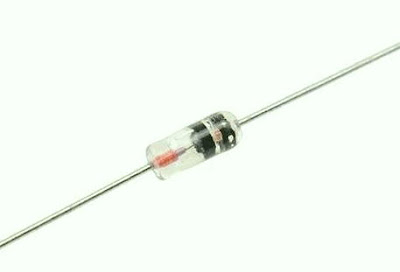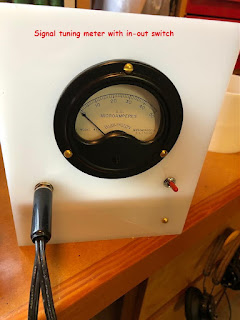 January’s Crystal Radio DX Contest
January’s Crystal Radio DX Contest
The first time I was involved with a crystal radio DX contest was about 20 years ago when I built a well-performing crystal receiver for the Yahoo Crystal Radio Group's annual DX contest. It was a great learning experience and taught me much about circuit losses and how to overcome them. I originally built several sets but was unable to hear anything other than local stations until I eventually figured things out ... the system was only as good as its weakest link or links!
Fast forward to more recently when I obtained and wrote about the Heathkit CR-1 Crystal Radio, a simple but very well-designed tuner that has become popular with collectors. Using the CR-1 re-kindled my interest in the DX contest activity of years ago and when talking with two other amateurs that had an interest as well (one had also been in the earlier contests sponsored by the Alabama Crystal Radio Group), we decided to bring the contest back once again. The Facebook Crystal Radio DX Contest Group was formed last fall, a set of rules drawn up and the contest date set for the first week of January of this year. This gave interested participants plenty of time to build something they could use in the contest.
I spent all of December designing and constructing a new contest radio, hopefully one with enough selectivity to get around the 15 local flamethrowers (10-50kW S9++ signals) that plague the band for me and eventually drove me from crystal radio activities.
The new radio makes use of several 'traps' to null strong signals ... two are in the antenna line while one is loosely coupled inductively to the detector tank circuit. The two inline trap coils are wound with Litz wire on ferrite toroids (R40C1) while the third is a basket-wound Litz coil (660/46) on a 4" diameter form.
The antenna tuning stage also uses the same ferrite material but in the rod / bar form. I wound a low-end as well as a high-end coil for the tuner using the same high-count Litz as on the big trap coil. The low-end coil is wound on a bundle of three rods while the high-end coil uses a single rod.
 |
| Antenna tuner |
The detector stage uses another Litz coil with this one being solenoid-wound on a 4" diameter form. Both the antenna tuner and the detector use excellent quality hi-Q ceramic insulated air variable capacitors (18-360 pfd). All components that handle RF are insulated from the plywood bases in order to reduce losses. Moving a capacitor from the plywood to the insulated standoffs makes a noticeable difference, something learned the hard way years ago but actually measured while using the new radio.
 |
| Detector stage |
The detector also has provisions for comparing various diodes as not all diodes are created equal ... not even all diodes with the same number! When testing and comparing diodes of the same type such as the popular 1N34 germanium, every once in awhile one of them will turn out to be noticeably more sensitive than the others. In my built-in B-A-C diode test module, the hottest diode is always mounted in middle-position A, making it easy to quickly compare by switching to the left for B or to the right for C. So far the best one I have found is the vintage Russian D18 germanium diode but an old 1N34 removed years ago from a 1950s-era Heathkit has given it a good run for the money! I've still several hundreds of early germanium diodes, pulled from old diode matrix boards years ago, to test against the D18 as well as numerous Schottky diodes.
Also on board the detector module is a Selectivity Enhancement Circuit (SEC) that increases selectivity by unloading some of the diode's effect on the detector coil, similarly to tapping the diode further down the tank coil. It uses a small butterfly capacitor seen to the right of the main tuning capacitor in the photo above. I found it extremely effective when needed and is well worth the addition to a high-performance tuner.
The detector stage is followed by an impedance-matching transformer for the sound-powered headphones. This stage also houses a 50uA meter to measure diode current / signal strength levels.
The meter can be switch-bypassed to prevent needle-bounce on stronger signals. It is particularly helpful when using the traps to null a signal to the minimum level.
The three traps utilized have been very effective in eliminating what I had originally perceived as an impossible DXing situation.
Here are the daytime-power signal strengths of my 15 line-of-site blowtorch stations that, without trapping, very effectively block most sections of the band. Anything over 50uA is ear shattering and problematic, usually requiring the use of all 3 traps:
KVRI 1600 50uA
KRPI 1550 100uA
CJVB 1470 40uA
CFTE 1410 350uA
CHMB 1320 100uA
CJRJ 1200 400uA
CKWX 1130 300uA
CKST 1040 90uA
CKNW 980 150uA
KGMI 790 100uA
CHMJ 730 450uA
CBU 690 650uA
CISL 650 200uA
CJWW 600 100uA
KARI 550 100uA
Overall I was very pleased and surprised at the good performance of the new radio. During the contest period I identified and logged 92 unique stations in 16 states / provinces. More than one station was logged on 9 different frequencies as the propagation varied from night to night.
Highlights of the DX Contest were hearing WHAS in Kentucky (2,007 miles), WJR in Michigan (1,970 miles), KXEL in Iowa (1,556 miles), WCCO in Minnesota (1,423 miles) and CBW-990 in Winnipeg, smack up beside local blowtorch CKNW-980! Additionally, hearing Washington state 250 watter KFLD-870 and 250 watt KWBY-940 in Oregon were great surprises.
I found the use of a spotter radio (Sony ICF-2010) to be very useful in locating signals to target and to zero-beat with an RF signal generator. The generator’s tone-modulated signal can then be tuned in and the xtal radio and antenna / detector stages optimized.
From here, any pest signals are then tuned to and individually nulled using the traps while watching the signal meter. Antenna and detector stages are then re-tweaked before disabling the generator and listening for the desired signal.
Often it is heard immediately following the above tuning procedures but if not, monitoring the frequency for several minutes often allows time for the weak signal to fade up to audible levels.
Comparing programming audio with what is heard on the spotter radio will confirm hearing the correct signal as will comparing audio to the station’s own live-feed on the internet.
Due to the larger and much better antenna (inverted-L 70’ x 100’) on the crystal radio, I would often hear good audible signals on it and not on the spotter (something that I found surprising) so often times it was productive to just tune around the band on the crystal radio, tweaking stages as required.
I’m looking forward to further improvements of the tuner as well as to the next DX Contest whenever that will be scheduled ... hopefully you can join in as well!
FREQ UTC STN LOCATION MI
550 1:04 KARI Blaine, WA 25
560 1:30 KPQ Wenatchee, WA 168
570 3:45 KVI Seattle, WA 107
580 3:42 KIDO Nampa, ID 492
600 1:17 CKSP Vancouver, BC 32
610 4:15 KONA Kennewick, WA 271
620 1:22 KPOJ Portland, OR 241
630 3:40 CHED Edmonton, AB 530
630 21:10 KCIS Edmonds, WA 87
650 1:05 CISL Richmond, BC 24
660 3:30 CFFR Calgary, AB 693
660 21:23 KAPS Mt. Vernon, WA 52
670 3:25 KBOI Boise, ID 807
690 1:06 CBU Vancouver, BC 19
710 3:21 KIRO Seattle, WA 108
730 1:02 CHMJ Vancouver, BC 22
750 3:55 KXTG Portland, OR 243
760 4:01 WJR Detroit, MI 1970
770 3:17 KATL Miles City, MT 831
780 4:00 KKOH Reno, NV 658
790 1:07 KGMI Bellingham, WA 39
810 4:05 KGO San Francisco, CA 786
820 1:59 KGNW Seattle, WA 106
830 2:20 WCCO Minneapolis, MN 1423
840 4:10 CFCW Camrose, AB 530
840 4:00 WHAS Louisville, KY 2007
850 4:20 KOA Denver, CO 1118
850 1:12 KHHO Seattle, WA 121
860 3:48 CBKF Saskatoon, SK 758
860 1:04 KPAM Troutdale, OR 226
870 4:30 KFLD Pasco, WA 266
880 1:17 KIXI Seattle, WA 102
890 4:35 CJDC Dawson Creek, BC 494
900 4:38 CKBI Prince Albert, SK 810
910 4:40 CKDQ Drumheller, AB 468
920 4:42 KXLY Spokane, WA 285
930 1:50 KBAI Bellingham, WA 37
940 4:45 CJGX Yorkton, SK 940
940 0:58 KWBY Woodburn, OR 256
950 4:50 KJR Seattle, WA 106
960 4:52 CFAC Calgary, AB 444
970 4:55 KBUL Billings, MT 722
980 1:08 CKNW New Westminster, BC 32
990 4:58 CBW Winnipeg, MB 1156
1000 3:45 KOMO Seattle, WA 105
1010 4:59 CBR Calgary, AB 453
1020 0:54 KWIQ Moses Lake, WA 216
1030 5:06 KTWO Casper, WY 918
1040 1:09 CKST Vancouver, BC 23
1050 5:10 CJNB N Battleford, SK 707
1060 5:07 CKMX Calgary, AB 441
1070 5:10 cfax Victoria, BC 33
1080 0:33 KFXX Portland, OR 232
1090 1:40 KFNQ Seattle, WA 109
1100 3:55 KFAX San Francisco, CA 779
1110 5:15 KRPA Oak Harbor, WA 48
1120 0:48 KPNW Eugene, OR 340
1130 1:10 CKWX Vancouver, BC 22
1140 5:20 CHRB High River, AB 443
1150 5:50 CKFR Kelowna, BC 185
1160 5:53 KSL Salt Lake Cty, UT 781
1170 1:11 KPUG Bellingham, WA 39
1180 5:09 KOFI Kalispell, MT 416
1190 5:55 KEX Portland, OR 241
1200 1:12 CJRJ Vancouver, BC 23
1260 5:58 CFRN Edmonton, AB 522
1290 6:00 KUMA Pendleton, OR 306
1290 6:00 KGVO Missoula, MT 449
1320 1:13 CHMB Vancouver, BC 23
1360 6:12 KKMO Tacoma, WA 115
1370 4:32 KXTL Butte, MT 535
1380 6:16 KRKO Everett, WA 88
1410 1:14 CFTE Vancouver, BC 22
1460 1:55 KUTI Yakima, WA 207
1470 1:15 CJVB Vancouver, BC 25
1480 1:20 KBMS Vancouver, WA 227
1520 1:05 KKXA Snohomish, WA 88
1520 1:13 KQRR Oregon City, OR 241
1530 4:30 KFBK Sacramento, CA 698
1540 1:50 KXPA Bellvue, WA 102
1540 4:46 KXEL Waterloo, IA 1556
1550 1:16 KRPI Ferndale, WA 31
1560 1:14 KVAN Burbank, WA 272
1580 6:25 KGAL Lebanon, OR 297
1590 1:22 KLFE Seattle, WA 91
1600 1:00 KVRI Blaine, WA 25
1620 1:30 KYIZ Renton, WA 111
1640 6:45 KDZR Lake Oswego, OR 239
1660 0:56 KBRE Merced, CA 812
1680 1:35 KNTS Seattle, WA 91
1690 0:53 KFSG Roseville, CA 705



















Very interesting article. Reminded me when I was in 7th grade and use to build crystal radios and listen to local stations. Never thought you could hear anything but local. Was lots of fun tho. Thanks for sharing!
Stephen W4TOL
Tnx Stephen. I thought the same thing until I came across the now defunct but great Yahoo Crystal Radio Group. My childhood experience led me to think that DX was not possible on these devices. When engineered properly they can perform amazingly well.
How did you measure the various currents such as 350 and 650 microamps on a 50 microamp meter?
What is the resistance in series with the diodes when using the 50 microamp and the higher current meters?
Can you tell me the DC resistance of the earphone transformer primary and the RF choke connected to the three diodes? I am trying to relate measurements I have made on a number of 1N34 diodes to differences in sensitivity when used as detectors.
Many thanks,
73,
Dick Hagedorn